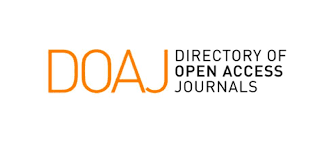Analysis of CI, HI, and DVH Values for the Heart Organ with IMRT Technique for Post-Mastectomy Breast Cancer Patients
Abstract
Breast cancer has a high incidence rate in Indonesia, necessitating treatment to improve patient survival. One of the treatment methods used is radiotherapy with the Intensity Modulated Radiation Therapy (IMRT) technique, aimed at delivering an optimal radiation dose to the tumor while minimizing radiation exposure to healthy organs, such as the heart. This study aims to analyze the dose distribution in the organ at risk (OAR) of the heart and evaluate the conformity of the Homogeneity Index (HI) and Conformity Index (CI) values in post-mastectomy breast cancer patients undergoing IMRT.The research was conducted using data from 10 post-mastectomy patients at Pelamonia Hospital. Data were collected through Dose Volume Histogram (DVH) analysis, including radiation doses at 98%, 50%, and 2% of the target volume. Additionally, the volume exposed to a 95% isodose and the percentage of heart volume receiving a dose of 25 Gy were analyzed. This data was used to calculate HI, CI, and the total dose received by the heart.The results showed that HI values ranged from 0.14 to 0.45, indicating variability in dose uniformity. Most patients had CI values above 0.9, ranging from 0.87 to 0.96, indicating good dose conformity with the tumor volume target. The heart doses received by all patients were below the tolerance limits set by QUANTEC (V25<10%). The IMRT technique effectively minimizes radiation doses to the heart while providing a dose distribution that meets ICRU standards, with HI and CI values approaching optimal levels. These findings suggest that IMRT is an effective method for treating post-mastectomy breast cancer.
Downloads
References
[2] Globocan, “Globocan,” Data kanker. [Online]. Available: https://gco.iarc.fr/today/en/ dataviz/pie?mode=cancer&group_populations=1, diakses 20 September 2024.
[3] S. Aras, İ. O. Tanzer, and T. İkizceli, Dosimetric Comparison of Superflab and Specially Prepared Bolus Materials Used in Radiotherapy Practice,Eur J Breast Health, vol. 16, no. 3, 2020, pp. 167–170.
[4] H. Rahmawati, D. ER, and R. D. Pakasi, Kanker Ovarium Disgerminoma,Indonesian Journal of Clinical Pathology and Medical Laboratory, vol. 19, 2016, no. 1.
[5] Kementerian Kesehatan RI, “Panduan Nasional Penanganan Kanker Payudara,” 2015, [Online]. Available: http://kanker.kemkes.go.id/guidelines/PNPKPayudara.pdf, Diakses 20 September 2024.
[6] Y. E. Daniartie et al, Analisis Treatment Planning System dengan Menggunakan Teknik Box dan Teknik Antero Posterior-Postero Anterior pada Kasus Kanker Serviks, Progressive Physics Journal, vol. 3, no. 1, 2022, p. 118.
[7] I. Wulandari, N. Heru Apriantoro, S. Sriyatun, and M. Haris, Penatalaksanaan Radioterapi Kanker Payudara Teknik Imrt, JRI (Jurnal Radiografer Indonesia), vol. 6, no. 1, 2023, pp. 15–21.
[8] D. Agustini, A. Winanda, and L. Prananto, Penatalaksanaan Radioterapi pada Kanker Payudara dengan Teknik IMRT Di Instalasi Radioterapi Rumah Sakit Gading Pluit, JUMANTIK : Jurnal Mahasiswa dan Penelitian Kesehatan, vol. 8, no. 1, 2021, pp. 36–39.
[9] H. Lia Dwikuntari, Ana Rima Setijadi, External beam radiation therapy, Advances in Accelerators and Medical Physics, vol. 02, no. 02,2017, pp. 375–392.
[10] M. Y. Errahmani et al., Association Between Cardiac Radiation Exposure and the Risk of Arrhythmia in Breast Cancer Patients Treated With Radiotherapy: A Case–Control Study, Front Oncol, vol. 12, 2022, pp. 1–9.
[11] N. A. P. Adi Rizka, Muhammad Khalilul Akbar, Carcinoma Mammae sinista T4bN2M1 Metastasis Pleura, AVERROUS: Jurnal Kedokteran dan Kesehatan Malikussaleh, vol. 8, no. 1, 2022, pp. 23–31.
[12] O. Febrietri, D. Milvita, and F. Diyona, Analisis Dosis Radiasi Paru-Paru Pasien Kanker Payudara dengan Teknik Three Dimensional Conformal Radiation Therapy (3D-CRT) Berdasarkan Grafik Dose Volume Histogram (DVH), Jurnal Fisika Unand, vol. 9, no. 1, 2020, pp. 110–117.
[13] Y. Asri et al, Perbandingan Radiasi Kanker Serviks Pada Organ Bladder Dengan Radioterapi LINAC Energi 10 MV Menggunakan Teknik 3DCRT dan IMRT Di RSUP Sanglah Denpasar Comparison of Cervical Cancer Radiation in Bladder Organs with 10 MV LINAC Energy Radiotherapy Using 3D, Buletin Fisika, vol. 19, no. 2, 2018, pp. 98–105.
[14] I. Y. P. Solehah, W. Kusumastuti, and M. Esterina, “Subjective Well-Being Pasien Kanker Pasca Mastektomi, Borobudur Psychology Review, vol. 2, no. 2,2022, pp. 82–93.
[15] ICRU report 62, Prescribing, Recording and Reporting Photon Beam Therapy (Supplement to ICRU 50), The International Commission on Radiation Units and Measurements. USA, 1999.
[16] ICRU Report 83, Prescribing, Recording and Reporting Photon Beam Intensity Modulated Radiation Therapy (IMRT), The International Commission on Radiation Units and Measurements. USA, 2010.
[17] S. Yani, Analisis Kurva Dose Volume Histogram (DVH) pada Teknik 3D Konformal dengan Metode Monte Carlo, Positron, vol. 11, 2021, no. 1, p. 19.
[18] S. N. Chen, P. Ramachandran, and P. Deb, Dosimetric comparative study of 3DCRT, IMRT, VMAT, Ecomp, and hybrid techniques for breast radiation therapy, Radiat Oncol J, vol. 38, no. 4, 2020, pp. 270–281.
[19] Z. Aulia and G. Illya, Evaluasi Pengaruh Penggunaan Bolus Terhadap Nilai Homogeneity Index , Conformity Index , Dan Mean Dose Oar Pada Tps Imrt Untuk Pasien Post-Mastectomy, jurnal Kesehatan Tambusai, vol. 5, no. 2, 2024, pp. 3999–4014.
[20] J. Booth et al., MLC tracking for lung SABR is feasible, efficient and delivers high-precision target dose and lower normal tissue dose, Radiotherapy and Oncology, vol. 155, 2021, pp. 131–137.
[21] ] S. Han-Oh, et al., Verification of MLC based real-time tumor tracking using an electronic portal imaging device, Med Phys, vol. 37, no. 6, 2010, pp. 2435–2440.
[22] E. Supriyaningsih et al., Comparison Of Risk Organ Distribution With Target Volume Size Variations Using Rapid Arc And Imrt Techniques For Case Of Lung Cancer, SANITAS : Jurnal Teknologi dan Seni Kesehatan, vol. 09, 2018, pp. 64–71.
[23] K. M. Atkins et al., Association of Left Anterior Descending Coronary Artery Radiation Dose with Major Adverse Cardiac Events and Mortality in Patients with Non-Small Cell Lung Cancer, JAMA Oncol, vol. 7, no. 2, 2021, pp. 206–219.










